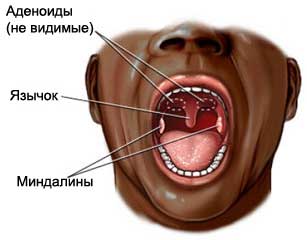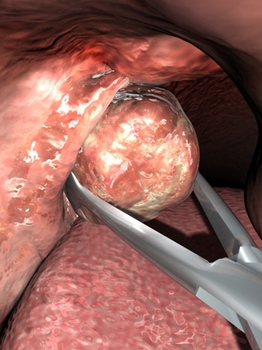Tonsillectomy – Tonsillectomy
Description tonsillectomy
Mindaliny – glands in the back of the throat. Tonsillectomy – is the surgical removal of the tonsils.

Reasons for tonsillectomy
Tonsillectomy often done in the case of no result in the application of the other non-surgical treatments for these diseases:
- Chronic or recurrent infections of the tonsils – Tonsillectomy may reduce the symptoms, but not completely eliminate, these infections;
- Peritonsillar abscess (the spread of infection beyond the tonsils);
- Enlarged tonsils, causing obstruction (zakuporku, violation of patency) throat.
Possible complications of tonsillectomy
Complications are rare, but no operation ensures no risk. If you plan to tonsillectomy, you need to know about possible complications, which may include:
- Bleeding;
- Temporary breathing problems;
- Adverse reaction to anesthesia;
- Vomiting and dehydration;
- Infection.
Factors, that may increase the risk of complications:
- Obesity;
- Smoking;
- Poor diet;
- Chronic illness;
- Serpovidnokletochnaya anemia;
- Blood clotting;
- Or recent or current treatment with steroids;
- Diabetes;
- Anticoagulation drugs or aspirinsoderzhaschih;
- Dehydration.
How is the removal of the tonsils?
Preparation for the procedure
Before the surgery, your doctor may be imposed or carried out following:
- Inspection of the tonsils, throat, Neck, and, perhaps, other parts of the body;
- Analysis of blood and, perhaps, Analysis of urine;
- The study of medical history and review of drugs taken.
In the run-up procedure:
- Tell your doctor about taking any medications. A week before surgery, perhaps, you need to stop taking certain drugs:
- Aspirin or other anti-inflammatory drugs;
- Blood thinners, such as clopidogrel (Plaviks) or warfarin;
- On the eve of the evening before surgery you can eat a light meal. Do not eat or drink anything the night.
Anesthesia
Most often used when removing the tonsils general anesthesia. Sometimes local anesthesia together with a sedative.
When using general anesthesia the patient will sleep during the procedure. When using a local anesthetic will numb the surgical site. The patient may receive a sedative, which will help you relax.
Procedure tonsillectomy
After IV or mask applied anesthetic. The doctor grabs tonsil with a special tool. Then tonsil separated from surrounding tissue and are removed. The tonsils may be cut out with a scalpel or hot cutting tool. To stop the bleeding at the surgical site will be used moxibustion electric shock or clips.

How long will the removal of the tonsils?
About 20-60 minutes.
Tonsillectomy – Will it hurt?
Anesthesia prevents pain during the procedure. After the procedure, you will be hard to swallow because of the pain in the throat. You may also experience pain in the ear.
To facilitate, pain doctor will give pain medicine or recommend a mild pain reliever, otpuskaemoe without prescription.
The average time of stay in the hospital after tonsillectomy
Typically, the extract is carried out the next day after the procedure. Some patients may need to stay in the hospital for two days.
Care after tonsillectomy
Care in a hospital
- Conducted surveillance to prevent negative reactions to anesthesia or other complications;
- After the expiry of anesthesia can go home.
Home Care
After returning home, follow these steps:, to ensure the normal recovery:
- Be sure to follow your doctor's instructions;
- Take your medicines as directed by your doctor;
- Avoid long conversations, cough within one week after surgery;
- Drink plenty of fluids;
- Avoid spicy, sour and indigestible food;
- Eat soft foods for 3-4 days after surgery. Gradually, you can return to a normal diet;
- Avoid swallowing hard foods, such as crackers and cookies. They can damage the back of your throat;
- Bath or shower can be taken as usual.
Contact your doctor after tonsillectomy
After discharge from the hospital need to see a doctor, if there was any of the following symptoms of:
- Signs of infection, including fever and chills;
- Redness, edema, strong pain, bleeding or discharge from the place of removal of the tonsils;
- Nausea and / or vomiting, that do not pass after taking the prescribed medicines and persist for more than two days after discharge from the hospital;
- Pain, which does not pass after taking pain medication appointed, especially if the pain interfere with drinking water;
- Cough, shortness of breath or chest pain;
- Saliva or vomiting blood;
- Other painful symptoms.
